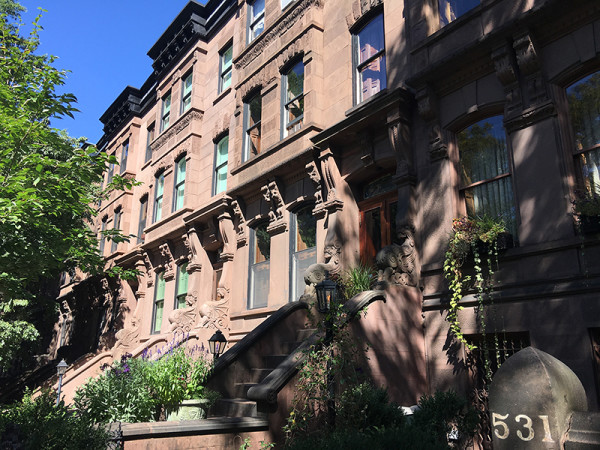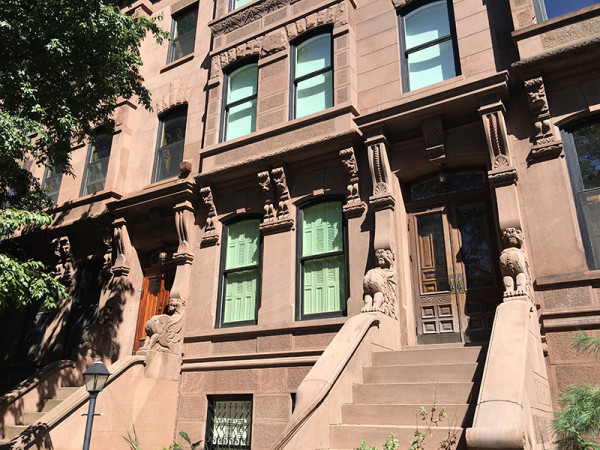Used in middle-class neighborhoods of East Coast cities between 1820 and 1890, brownstone offered a handsome Italianate-style veneer as well as the prestige of stone-considered more sophisticated than the mundane brick structure it covered. It was also easy to quarry, inexpensive, plentiful, and soft enough for fine carving and honing, making it a favorite among 19th-century masons. More than 50,000 row houses in the Northeast were finished with brownstone, and because of the high demand, the best quality stone was not always available. Historical records show that some brownstone began deteriorating 30, 20, and even 10 years after it was installed, says Alex Herrera, director of technical services at the New York Landmarks Conservancy.
In the 1950s many Brooklyn residents tried to disguise these modern ruins by covering their tattered facades with aluminum siding, faux brick, and paint. By the 1970s, however, preservation-minded folks began to look for more appropriate choices. Patching with a mixture of cement, sand, lime, and mortar colors became the preferred fix. It was economical as well as offering a range of shades-from a seductive dark chocolate to milky cocoa-to match the brownstone.
Today there’s a resurgence in preserving these Brown Decades buildings, in part because of the success of commercial patching materials and masons who have perfected their own patching brews and techniques over the years. Another boost is the reopening of the Portland Brownstone Quarries in Portland, Connecticut, which supplied 85 percent of the original brownstone used in New York and surrounding areas. This source offers homeowners whose homes were originally Portland brownstone the choice of in-kind repairs on small restoration jobs or, if their budget allows, refacing the entire building with in-kind stone. When it comes time to do the work, homeowners should consider how long they want the treatment to last and what they want it to look like, says Ivan Myjer, principal of Building and Monument Conservation in Arlington, Massachusetts.

A row of classic brownstones in Brooklyn, New York.
Why Brownstone Fails
Brownstone is a medium- to coarse-grained red-brown sandstone, usually with noticeable mica content that gives the stone its characteristic sparkle. The stone is held together with silica and clay, and Myjer says it’s the weaknesses of these elements that lead to most of the damage. These minerals swell after long periods of exposure to moisture and don’t return to their original size when the stone dries. This action causes small cracks, usually along the bedding planes, allowing more water to enter. Then pointing may crumble between blocks of brownstone, compounding the problem; as these joints open up, they allow water to seep in. When the temperature drops, the water freezes, expands, and further damages the stone in a continuing freeze-thaw cycle. Crumbling architectural details on top of a building may also channel water in patterns that severely wear away the brownstone facade. Drainage problems such as this must be corrected before repairing the brownstone itself. Maintenance of mortar joints, flashing, roofs, gutters, downspouts, and coping stones limit the amount of water that enters the masonry wall.
Another reason brownstone fails is that it typically was face-bedded, with the stone’s planes (layers) set perpendicular to the ground, rather than naturally bedded, with the bedding planes set parallel to the ground. This installation method allows water to penetrate through weakened mortar joints and flashing and into the stone’s layers. Face bedding was fast, aesthetically pleasing, and less costly-but definitely not the way Mother Nature intended. The stone spalls or flakes off, roughening the once smooth surface. Although you can counteract some water problems, you’re stuck with the original orientation.
Brownstone Patching Techniques
Building out with patching materials is a common treatment for re-creating lost surfaces, profiles, and finishes. Approximately 95 percent of brownstone repair in New York involves patching, according to Herrera. Along with first-time repairs, some of this restoration includes reworking patches that have begun to fail. Unfortunately, when an old patch fails there’s usually not enough substrate remaining to repatch. The original veneer was typically only 3 thick. Plus, as the patch reaches the end of its serviceable life, the underlying stone tends to deteriorate. Replacing the stone in-kind is the safest alternative at this point, says Myjer.
Crushed brownstone (found at salvage yards) is a desirable component for a patching mix used on a Portland brownstone building because other aggregates lack mica particles and look flat in contrast. The mix should contain 1 part portland cement, 1 part lime, 6 parts sand, crushed brownstone, dry mortar colors, and water.
The amounts of mortar color and water vary, depending on the right color and consistency. Experiment first with the dry masonry colors, then introduce the cement and brownstone.
Begin with white portland cement to avoid introducing unwanted color to the mix. If you find you need a greyer hue, use a light grey portland. Match the color of the original brownstone, not the weathered surface.
When you undercut you’ll expose unweathered stone. As the patch weathers, it will appear more like the stone facade. Many masons add the dry mortar colors and crushed stone only to the finish coat.
Applying the Mix
1.) Patch when you can rely on the temperature remaining at 45 degrees or above for a 72-hour period. Using a hammer and chisel, cut back the stone to a solid subsurface.
2.) Undercut the perimeter of the patch to provide a key (a rough surface) to hold the mix. Once the deteriorated stone has been removed, bore 1/4 diameter holes approximately 1/2 deep at varying angles, about every 2 along the newly exposed surface.
3.) Remove all loose and deteriorated stone, dust, and dirt from the patch area and lightly spray with water.
4.) Then apply a bonding agent-a thin paste consisting of 1 part portland cement, 2 parts lime, and 6 parts sand mixed with water.
5.) After the bonding agent is in place, apply the first layer of patching mix, called the scratch coat, to the area. The mix must be applied in layers no less than 3/4 and no more than 3 thick. Layering is very important to the success of the patch, says Herrera.
6.) To provide keying for each layer, use a trowel to gouge many scratches into the surface of the previous layer while it is still damp. Wait 2 to 4 hours before applying another coat.
When working on small patch jobs, it is important not to patch across a building’s mortar joints, says Myjer. Each stone expands and contracts individually, and if you bond two stones together they will ultimately crack.

Healthy brownstone facades and ornamentation.
In-Kind Repairs
The Secretary of the Interior’s Standards for Preservation rank in-kind replacement as being far preferable to replacement with alternative materials. In some cases, repairing with stone can cost the same as using patching materials. A partial replacement, called a dutchman, involves removing deteriorated portions of the stone and inserting a piece of stone that is profiled and tooled to match the adjacent areas. These types of repairs should only be done by a skilled mason, says Myjer.
Get a mason’s advice when choosing replacement stone. The ultimate strength of sandstone, measured in terms of psi, is not a good indicator of how a stone will weather. Porosity, permeability, and chemistry of the stone’s binder and mineral components are far more important than ultimate strength, Myjer says. It’s also important to use stone from the original source. Do your homework to find out if your row house is made with Portland brownstone. Whether choosing to patch the stone or replace in kind, keep in mind how long you want the repair job to last. If a patch is done well it could last anywhere from 20 to 40 years or so, but replacing in kind could last 100 years, according to Myjer.
OHJ thanks Ivan Myjer, principal of Building Monument Conservation in Arlington, Massachusetts, for his help with this article. Myjer is restoring the Cooper Union in New York City, hand selecting stone from the Portland Brownstone Quarries. OHJ also thanks Alex Herrera, director of technical services at the New York Landmarks Conservancy.







